Reports on Plant Diseases |
|
RPD No. 942
- Gray-Mold Rot or Botrytis Blight of Vegetables
|
May 2000
|
[ Symptoms
] [ Disease Cycle ] [ Control
]
|
Gray-mold rot or Botrytis blight, caused by the wide-spread fungus Botrytis
cinerea, affects most vegetable and fruit crops, as well as a large number
of shrubs, trees, flowers, and weeds.
The disease is favored by cool moist conditions and little or no wind.
Cool, damp, poorly ventilated greenhouses are ideal for the disease, and
Botrytis blights are probably the most common diseases of greenhouse-grown
crops, especially in the spring and fall when the vents of greenhouses
are closed at night to prevent heat loss. In the greenhouse, gray mold
is often said to be a disease of bad management. Gray-mold losses in the
field are severe following prolonged periods of overcast skies, fogs,
heavy dews, or light drizzly rains.
The fungus causes primarily blossom blights and fruit rots, but can also
cause damping-off, bud rot, stem cankers or rots, leaf spots or blights,
bulb rots, and tuber or root rots. Botrytis is also a problem on fruits
and vegetables in cold storage and subsequent shipment because the fungus
is able to function at temperatures just above freezing. With some possible
exceptions, Botrytis mainly attacks tender tissues (flower petals, buds,
or seedlings), weakened or injured tissues, and aging (senescent) and
dead tissues. Actively growing tissues, other than flower petals, are
seldom invaded directly.
Symptoms
Symptoms of Botrytis diseases vary greatly depending on the host and
plant part attacked. Generalized symptoms include a gray to brown discoloration,
water soaking, and a fuzzy whitish gray to tan mold (mycelium and spores)
growing on the surface of affected areas.
Blossom Blights and Fruit Rots
Blossom blights often precede and lead to fruit and stem rots. Aging
flower petals of beans, carrot, celery, eggplant, onion, pepper, squash,
and tomato are particularly susceptible to colonization by Botrytis species,
and under cool, humid conditions abundant mycelium and conidia (spores)
are produced on colonized petals. The fungus often grows from the fading
flower petals into the rest of the inflorescence, or into developing fruit
where it causes a blossom-end rot. From there it can spread and destroy
part or all of the fruit.
Fruit can also be infected by conidia entering through growth cracks,
cuts, stem scars, insect wounds, or lesions made by other pathogens. Infected
fruit develop water-soaked, yellowish green or grayish brown irregular
lesions which can be somewhat soft and spongy in texture. When conditions
are favorable, mycelium and conidia are produced on the lesion surface.
The fungus can infect the fruit of cucumber; squash; eggplant; pepper
(Figure 1); snap (Figure 2), kidney, and Lima beans; lentils; and tomato
(Figure 3) to name a few.
Back to Top
|
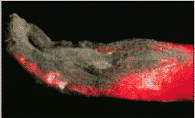
Figure 1.
Botrytis fruit rot of pepper. Note the typical dense gray mold on the
decayed area (courtesy Dr. A.O. Paulus).
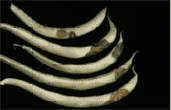
Figure 2.
Gray mold lesions on pods of snap beans.
|
|
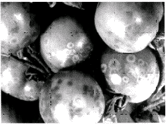
Figure 3.
Young Botrytis lesions ("ghost spot") on green tomato fruits
(courtesy BASF).

Figure 4.
Botrytis blight has killed young lettuce plant.
|
Leaf and Head Rots
Botrytis leaf infections can develop on some crops. Leaf symptoms first
appear as small, soft, yellowish or tan spots. Later the spots become
whitish gray or tan, and may enlarge and coalesce to the point where
they can involve the entire leaf. Lettuce (Figure 4), escarole, endive,
onion, and cabbage may be damaged severely. Botrytis first infects the
lower, older leaves, often those in contact with the soil. Diseased
areas become yellow and support a heavy growth of gray mold. Under cool,
moist conditions, lettuce heads may be covered with fuzzy gray mold.
The inner leaves commonly become a slimy mass. Under dry conditions,
a firm brown-to-black decay rots the stem base, and the head breaks
off and dries up. Sometimes there is no external evidence that the inner
leaves have rotted. Leaf rot is also common on greenhouse-grown rhubarb
and rape. Onion leaves damaged by ozone are particularly susceptible
to Botrytis leaf infection with lesions developing directly on the ozone-damaged
spots.
Damping Off
Seedlings collapse from a soft, tan-to-brown, water-soaked rot of the
stem at or near the soil line. The typical gray mold soon develops on
the decayed tissue. Damping-off of vegetable and flower seedlings by
Botrytis occurs primarily in cold frames where the humidity is high,
but can also occur in the field if the seeds are contaminated with sclerotia
or mycelium, or if Botrytis is present in the soil.
Back to Top
|
Stem and Bud Rots
Stems or stalks of tomato and many other plants can be infected in the
greenhouse or field through leaf scars or wounds, or leaf infections can
progress into stem tissue. Stem lesions are dark, sunken, and elongated
with distinct margins, or they may spread throughout the stem. In cloudy,
wet weather infected tissues become covered with the typical grayish brown
mold (Figure 5), and hard, black sclerotia may be produced. Asparagus
"spears" are sometimes blighted and covered with the typical
gray mold. Small, soft lesions can develop on the scale tips and actively
growing buds of artichoke. Infections often progress from the buds down
the stalk and into the lateral branches and main stem. Globe artichoke
buds may be covered with a fine white mold, and when conditions are dry,
a firm brown-to-black decay develops.
Bulb and Root Rots
Lesions can develop on any part of the root or bulb surface, but they
are more likely to form at the crown, at wounds, or at the lower tip.
Lesions usually appear soft, watery, and tan in color, later becoming
somewhat spongy, dark brown, and lightweight. Eventually affected tissues
may dry to form a grayish, leathery decay. Pockets of mycelium may develop
between decayed bulb scales or on the surface of root lesions. Black sclerotia
can also form on and in decayed tissue, except at low temperatures, when
only a fine white mold develops. Gray mold rot causes considerable damage
on stored carrot (Figure 6), parsnip, mangel, beet, endive, chicory, turnip,
and rutabaga, but usually affects only topped roots. The bulb rot phase
is common on onion (Figure 7) and garlic, but also occurs on other bulb
crops.
Back to Top
|

Figure 5.
Botrytis canker on a wounded tomato stem.
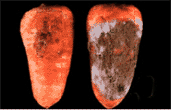
Figure 6.
Gray-mold rot on carrot.
|

Figure 7.
Neck rot of onion caused by Botrytis allii.
|
Disease Cycle
Outdoors Botrytis overwinters in the soil as mycelium on plant debris,
and as black, hard, flat or irregular sclerotia in the soil and plant
debris, or mixed with seed. The fungus is spread by anything that moves
soil or plant debris, or transports sclerotia. The fungus requires free
moisture (wet surfaces) for germination, and cool 60 to 77 F (15 to 25
C), damp weather with little wind for optimal infection, growth, sporulation,
and spore release. Botrytis is also active at low temperatures, and can
cause problems on vegetables stored for weeks or months at temperatures
ranging from 32 to 50 (0 to 10 C). Infection rarely occurs at temperatures
above 77 F (25 C). Once infection occurs, the fungus grows over a range
of 32 to 96 F (0 to 35 C).
Masses of microscopic conidia (asexual spores) are produced on the surface
of colonized tissues in tiny grape-like clusters (Figure 8). They are
carried by humid air currents, splashing water, tools, and clothing, to
healthy plants where they initiate new infections. Conidia usually do
not penetrate living tissue directly, but rather infect through wounds,
or by first colonizing dead tissues (old flower petals, dying foliage,
etc.) then growing into the living parts of the plant.
Sclerotia are the primary means of survival in the field, and are viable
within a temperature range of 39 to 131 F (4 to 54 C). The sclerotia generally
produce conidia, and occasionally infection hyphae which can penetrate
directly. The sclerotia can also produce apothecia (a sexual fruiting
body), which in turn, produce ascospores that are also infective. Production
of conidia and surface mycelium is inhibited by air movement at moderate
humidity levels.
|
Back to Top
|
Control
1. Buy high-quality seed of recommended varieties. Treat the seed before
planting.
2. Plant in a light, well-drained, well-prepared, fertile seedbed at
the time recommended for your area. If feasible, sterilize the seedbed
soil before planting, preferably with heat. Steam all soil used for plantbeds
at 180 F (81 C) for 30 minutes or 160 F (71 C) for one hour.
3. Avoid heavy soils, heavy seeding, overcrowding, poor air circulation,
planting too deep, over-fertilizing (especially with nitrogen), and wet
mulches.
4. Strive for steady vigorous plant growth, not a soft luxuriant growth.
Fertilize plants on the basis of a soil test.
5. Keep the greenhouse and seedbed soil somewhat dry after planting.
Allow plants to get plenty of light. Keep the greenhouse, hotbed or cold
frame glass clean. The glass sash should not leak water on the plants.
6. In greenhouses and seedbeds, provide for maximum air circulation,
avoid excessive humidity, and do not allow water to form on the foliage.
At night, maintain the greenhouse temperature higher than that outdoors,
to prevent condensation of water on leaves. Some night heating may be
necessary in Illinois through mid-June and starting again in early September.
7. Circulate the air with fans when heating greenhouses to keep warm,
dry air in motion, and to prevent the development of stagnant air pockets.
Botrytis will not be a problem if the humidity is kept below 90 percent.
8. Where possible, practice surface watering. Keep water off the foliage.
Water plants early in the day to allow time for the foliage to dry before
sunset.
9. Apply recommended fungicides when conditions favor disease development.
Fungicides should be used with caution because the gray mold pathogen
is often quick to develop fungicide-tolerant races; fungicides then only
serve to suppress natural competitors, often making the disease more severe.
10. Where practical in greenhouses and gardens, carefully remove the
first fruit infected with gray-mold rot from the growing area and burn
or bury. Ideally, all diseased plants and plant parts should be removed
and destroyed.
11. Avoid wounding or damaging the fruit during harvest and handling,
and remove debris from storage areas. Store only blemish-free, clean vegetables
in a cool environment where the humidity is high enough to prevent shriveling,
but does not allow free moisture to form. The temperature for most vegetables
should be as close to freezing as possible.
12. After harvest, where feasible, carefully collect, remove and burn,
or cleanly plow under all crop debris.
|
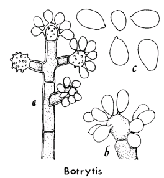
Figure 8.
Botrytis as it would appear under high power of a light microscope:
a, conidiophore of botrytis cinerea bearing grapelike clusters of spores
(conidia); b, sporulating tip of a conidiophore; c, mature conidia (drawing
by L. Gray)
|
Information concerning insecticides, weed control, varieties, and other recommendations
can be found in the Illinois Homeowners' Guide to Pest Management, available
at your nearest Extension office.
Back to Top
|



